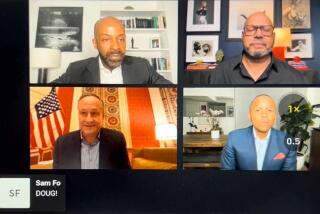Remap May Shift More Than Borders : Politics: As state lawmakers prepare to redraw boundaries, the big question is whether 44th Assembly District will retain its liberal agenda and close ties to the coastline.
The Westside’s 44th Assembly District seems to delight in being different.
While voters elsewhere marched to more conservative tunes in recent years, the 44th--where politics and art are as likely dinner-table topics as game scores and skin-care tips--remained unabashedly liberal.
In the 1990 governor’s race and the 1988 and ’84 presidential campaigns, that translated into huge margins of support for losing Democratic hopefuls Dianne Feinstein, Michael S. Dukakis and Walter F. Mondale. And every two years since 1982, the district’s voters have sent onetime anti-war activist Tom Hayden to the state Assembly, where he has championed such causes as coastal protection on their behalf.
Now, as Hayden and his legislative colleagues reconvene Monday to begin the complex task of redrawing the state’s political boundaries, the question of whether the 44th District will emerge with its distinctive character intact is among the many issues awaiting resolution.
At heart, the arcane reapportionment process is about preserving--or redistributing--political power. And a close examination of the factors at work involving the 44th District offers an object lesson in the overall challenges facing lawmakers, especially in terms of Westside neighborhoods.
Stretching from Malibu to Santa Monica and Venice and jogging inland to encompass Century City and much of Rancho Park, the district’s most obvious characteristic is its link to the coastline. As a result, environmental issues--especially those concerning Santa Monica Bay--are high priority items.
The district also is noted for its commitment to a progressive political agenda, a sophisticated approach to achieving those aims and a large concentration of Jewish voters.
During the 1980s, however, the district was marked by a trend that is of overriding importance in redistricting--a growth rate that failed to keep pace with the statewide population boom.
The state’s 1990 population of about 29.7 million means that each of the Assembly’s 80 districts must include 372,000 people. Census figures put the population of the 44th District at 307,237--meaning its boundaries must be changed to add slightly less than 65,000 people.
That, in turn, means something has to give somewhere, with the prospects ranging from a dramatic reconfiguration of the district to a similarly dramatic scheme that would essentially collapse two nearby districts into one. And within those two options lie a myriad of less extreme possibilities.
Ironically, the very geography that defines the 44th District limits the options for redrawing it--the Pacific Ocean blocks any boundary expansion to the west. That makes it virtually inevitable that the district will have to stretch inland. But how far inland becomes a matter of debate.
Hayden has said that he will work to retain the district’s basic makeup. And former Santa Monica City Councilwoman Christine Reed maintained that the environmentally conscious district should continue to hug the coast.
“Keeping coastal communities intact,” she said, enhances the district’s focus on such environmental issues as cleaning up pollution in Santa Monica Bay.
But using a coastal route to provide the district with the additional population it needs is easier said than done. If the district stretched north into Ventura County, it would likely turn more conservative and more Republican, according to one veteran Los Angeles campaign consultant.
Going south poses the same dilemma. The district could stretch into the South Bay, but that also would dilute the Democratic vote, said the consultant, who asked not to be named.
Two other factors add potential complications to the shape the 44th District will take in the next decade: a federal law requiring that heavily minority districts--such as the neighboring 49th represented by Democrat Gwen Moore--be protected, and Hayden’s own political plans.
Changes made to the federal Voting Rights Act in recent years require that whenever possible, drafters of reapportionment plans must put enough minorities in a district so that they can elect their own representative, but not pack in so many that their voting strength is weakened in adjoining districts.
While the law is not expected to directly affect the 44th District, it will influence the way map makers redraw the 49th District, which Moore, who is black, has represented since 1978. Blacks make up about 42% of the district’s population, and it is unlikely that percentage would be allowed to dip. As a result, the 44th District probably could not snake into minority areas in the 49th to pick up more population.
Meanwhile, if Hayden were to let it be known during the reapportionment battle that he has decided not to run for reelection in 1992, the new 44th District could bear no resemblance to its old shape.
Hayden has been frequently mentioned as a potential congressional candidate next year. And Republican Assemblyman Richard L. Mountjoy of Monrovia, a GOP redistricting strategist, said that one scenario he has heard envisions carving up the 44th District among several others if Hayden seeks higher office.
The potential impact of that was spelled out by one Democratic elected official, who asked not to be identified. The official noted that the environmental issues that have been Hayden’s major priorities could be expected to take a back seat if coastal areas become mere appendages in other districts. A lawmaker whose constituency largely was composed of inner-city residents, for instance, would be expected to be more concerned with job creation, the official said.
In a recent interview, Hayden declined to spell out his political plans in any detail. “My intention is to stay in the state Legislature, but I’m exploring other possibilities,” he said.
He added that he plans to discuss his political options later this year with Democratic Assembly Speaker Willie Brown of San Francisco and some of his other friends.
But Assemblyman Terry B. Friedman (D-Los Angeles), whose 43rd District includes Beverly Hills, Brentwood, Bel-Air and other parts of the Westside, said legislators eyeing higher office may have to make that decision sooner rather than later.
“People are going to have to let their intentions be known,” Friedman said.
Even if Hayden decides to remain in the Assembly, he may have to fight off efforts by neighboring Democrats to raid portions of his district.
Other Westside Assembly members are keeping a close eye on the heavily Jewish pockets of the 44th District because they would like to raid these solidly Democratic constituents to help bring their districts up to the 372,000 population mark.
The Westside districts in this category are represented by Friedman, Burt Margolin and Democrat Barbara Friedman, who on July 30 won a special election for the seat formerly held by Democrat Mike Roos.
As with 44th District, these other districts must gain population, leaving Democratic strategists scratching their heads for a formula that protects all the incumbents while preserving the basic boundaries of Moore’s heavily minority district, which runs from Marina del Rey to the Crenshaw community.
One Assembly staff member close to the remapping process is skeptical that any plan can be drawn that accomplishes these goals. He said the Democrats “can’t maintain the number of seats (on the Westside) there is now.”
In Sacramento, speculation has focused on parceling out pieces of the 46th District, which was Roos’ seat, to other Democrats. Under this scenario, Friedman would seek reelection next year in a district largely composed of what is now the 45th District, currently held by Margolin, while he would campaign for Congress.
The 44th at a Glance * 1990 population: 307,237, 64,763 short of the number required for each of the state’s 80 Assembly districts.
Ethnic Breakdown
* 77% white
* 15.3% Latino
* 8.3% Asian
* 7% black
Figures for whites, Asians and blacks include those who also declared themselves Latino Voter Registration
* Total: 169,346
* Democrats: 100,103
* Republicans: 49,415
* American Indep.: 1,365
* Peace and Freedom: 822
* Libertarian: 789
* Others: 691
* Declined to state: 16,161
Source: Los Angeles County Registrar-Recorder, state Assembly and Secretary of State
Reapportionment and the 44th District
An examination of factors expected to influence the redistricting of the Westside’s 44th Assembly District offers, in a microcosm, a look at the overall challenges facing state lawmakers in the reapportionment process. Adjustments made to the district’s boundaries could dramatically alter surrounding districts, and vice versa. A key question surrounding the 44th will be whether it retains its coastal character.
More to Read
Get the L.A. Times Politics newsletter
Deeply reported insights into legislation, politics and policy from Sacramento, Washington and beyond. In your inbox three times per week.
You may occasionally receive promotional content from the Los Angeles Times.






